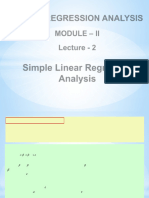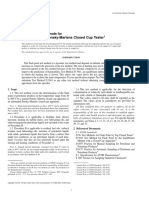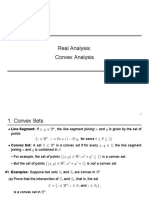Linear Regression Analysis: Module - Ii
Linear Regression Analysis: Module - Ii
Uploaded by
Lola SamCopyright:
Available Formats
Linear Regression Analysis: Module - Ii
Linear Regression Analysis: Module - Ii
Uploaded by
Lola SamOriginal Title
Copyright
Available Formats
Share this document
Did you find this document useful?
Is this content inappropriate?
Copyright:
Available Formats
Linear Regression Analysis: Module - Ii
Linear Regression Analysis: Module - Ii
Uploaded by
Lola SamCopyright:
Available Formats
Dr.
Shalabh
Department of Mathematics and Statistics
Indian Institute of Technology Kanpur
LINEAR REGRESSION ANALYSIS
MODULE II
Lecture - 4
Simple Linear Regression
Analysis
2
Maximum likelihood estimation
We assume that are independent and identically distributed following a normal distribution
Now we use the method of maximum likelihood to estimate the parameters of the linear regression model
the observations are independently distributed with for all The likelihood
function of the given observations and unknown parameters and is
The maximum likelihood estimates of and can be obtained by maximizing or equivalently
where
The normal equations are obtained by partial differentiation of log-likelihood with respect to and equating them
to zero
2
' ( 1,2,..., )
i
s i n =
2
(0, ). N
0 1
( 1,2,..., ),
i i i
y x i n = + + =
( 1,2,..., )
i
y i n =
2
0 1
( , )
i
N x + 1,2,..., . i n =
( , )
i i
x y
0 1
,
1/2
2 2
0 1 0 1 2 2
1
1 1
( , ; , , exp ( ) .
2 2
n
i i i i
i
L x y y x
=
| | (
=
|
(
\ .
0 1
,
2
2
0 1
( , ; , , )
i i
L x y
2
0 1
ln ( , ; , , )
i i
L x y
2 2 2
0 1 0 1 2
1
1
ln ( , ; , , ) ln2 ln ( ) .
2 2 2
n
i i i i
i
n n
L x y y x
=
| | | | | |
=
| | |
\ . \ . \ .
2
0 1
0 1 2
1 0
2
0 1
0 1 2
1 1
2
2 0 1
0 1 2 2 4
1
ln ( , ; , , ) 1
( ) 0
ln ( , ; , , ) 1
( ) 0
ln ( , ; , , ) 1
( ) 0.
2 2
and
n
i i
i i
i
n
i i
i i i
i
n
i i
i i
i
L x y
y x
L x y
y x x
L x y n
y x
=
=
=
= =
= =
= + =
0 1
,
2
The solution of these normal equations give the maximum likelihood estimates of and as
respectively.
3
It can be verified that the Hessian matrix of second order partial derivation of ln L with respect to , and is negative
definite at and which ensures that the likelihood function is maximized at these values.
Note that the least squares and maximum likelihood estimates of and are identical when disturbances are normally
distributed. The least squares and maximum likelihood estimates of are different. In fact, the least squares estimate of is
so that it is related to maximum likelihood estimate as
Thus and are unbiased estimators of and whereas is a biased estimate of , but it is asymptotically unbiased.
The variances of and are same as that of b
0
and b
1
respectively but the mean squared error
0 1
,
2
0 0 1 1
, , b b = =
2 2
s =
0
2 2
1
1
( )
2
n
i
i
s y y
n
=
=
2 2
2
.
n
s s
n
=
0
b
1
b
2
s
2
0
b
1
b
2 2
( ) ( ). MSE s Var s <
0 1
,
2
0 1
1
1
2
1
2
0 1
2 1
( )( )
( )
( )
,
and
n
i i
xy
i
n
xx
i
i
n
i i
i
b y b x
x x y y
s
b
s
x x
y b b x
s
n
=
=
=
=
= =
4
Testing of hypotheses and confidence interval estimation for slope parameter
Now we consider the tests of hypothesis and confidence interval estimation for the slope parameter of the model under two
cases, viz., when is known and when is unknown.
Case 1: When is known
Consider the simple linear regression model It is assumed that are independent
and identically distributed and follow
First we develop a test for the null hypothesis related to the slope parameter
where is some given constant.
Assuming to be known, we know that
and is a linear combination of normally distributed , so
and so the following statistic can be constructed
which is distributed as N(0, 1) when H
0
is true.
2
0 1
( 1,2,..., ).
i i i
y x i n = + + = '
i
s
2
(0, ). N
0 1 10
: H =
10
2
1 1
~ ,
xx
b N
s
| |
|
\ .
1 10
1
2
xx
b
Z
s
=
2
1
b
' .
i
y s
2
1 1 1
( ) , ( )
xx
E b Var b
s
= =
The confidence interval for can be obtained using the Z
1
statistic as follows:
5
So confidence interval for is
where is the percentage point of the N(0,1) distribution.
1
1
2 2
1 1
2
2 2
2 2
1 1 1
2 2
1
1
1 .
xx
xx xx
P z Z z
b
P z z
s
P b z b z
s s
(
=
(
(
(
(
=
(
(
(
(
+ = (
(
1
2 2
1 /2 1 /2
,
xx xx
b z b z
s s
| |
+ |
|
\ .
/2
z
/ 2
A decision rule to test can be framed as follows:
Reject H
0
if
where is the percentage points on normal distribution. Similarly, the decision rule for one sided alternative
hypothesis can also be framed.
1 1 10
: H
0 /2
Z z
>
/2
z
/ 2
100(1 )%
100(1 )%
6
Case 2: When is unknown
When is unknown, we proceed as follows. We know that
and
Further, and b
1
are independently distributed. This result will be proved formally later in module on multiple linear
regression. This result also follows from the result that under normal distribution, the maximum likelihood estimates, viz.,
sample mean (estimator of population mean) and sample variance (estimator of population variance) are independently
distributed so b
1
and s
2
are also independently distributed.
2
2
.
2
res
SS
E
n
| |
=
|
\ .
2
2
2
~ ( 2).
res
SS
n
2
/
res
SS
Thus the following statistic can be constructed:
which follows a t-distribution with (n - 2) degrees of freedom, denoted as , when H
0
is true.
1 1
0
2
1 1
2
~
( 2)
xx
n
res
xx
b
t
s
b
t
SS
n s
2 n
t
7
A decision rule to test is to
reject if
where is the percentage point of the t-distribution with (n - 2) degrees of freedom.
Similarly, the decision rule for one sided alternative hypothesis can also be framed.
1 1 10
: H
0
H
0 2, /2 n
t t
>
2, /2 n
t
/ 2
The confidence interval of can be obtained using the t
0
statistic as follows :
So the confidence interval is
0
2 2
1 1
2
2 2
2 2
1 1 1
2 2
1
1
1 .
xx
xx xx
P t t t
b
P t t
s
P b t b t
s s
(
=
(
(
(
(
=
(
(
(
(
+ = (
(
1
1 2, /2 1 2, /2
, .
( 2) ( 2)
res res
n n
xx xx
SS SS
b t b t
n s n s
| |
+
|
|
\ .
1
100(1 )%
100(1 )%
8
Testing of hypotheses and confidence interval estimation for intercept term
Now, we consider the tests of hypothesis and confidence interval estimation for intercept term under two cases, viz., when
is known and when is unknown.
Case 1: When is known
Suppose the null hypothesis under consideration is
where is known, then using the result that is a linear combination of
normally distributed random variables, the following statistic
has a N(0, 1) distribution when H
0
is true.
A decision rule to test can be framed as follows:
Reject H
0
if
where is the percentage points on normal distribution.
Similarly, the decision rule for one sided alternative hypothesis can also be framed.
1 0 00
: H
0 /2
Z z
>
/2
z
/ 2
2
0 0 00
: , H =
2
0 00
0
2
2
~ (0,1),
1
xx
b
Z N
x
n s
=
| |
+
|
\ .
2
2
2
0 0 0 0
1
( ) , ( ) and
x
x
E b Var b b
n s
| |
= = +
|
\ .
9
The confidence intervals for when is known can be derived using the statistic as follows::
So the of confidential interval of is
2
100(1 )%
0
0
2 2
0 0
2
2 2
2 2
2 2
0 0 0
2 2
1
1
1
1 1
1 .
xx
xx xx
P z Z z
b
P z z
x
n s
x x
P b z b z
n s n s
(
=
(
(
(
(
=
(
| |
(
+
|
(
\ .
(
| | | |
( + + + =
| |
( \ . \ .
0
2 2
2 2
0 /2 0 /2
1 1
, .
xx xx
x x
b z b z
n s n s
| |
| | | |
| + + +
| |
|
\ . \ .
\ .
0
Z
100(1 )%
10
Case 2: When is unknown
When is unknown, then the statistic is constructed
which follows a t-distribution with (n - 2) degrees of freedom, i.e., when H
0
is true.
A decision rule to test is as follows:
Reject H
0
whenever
where is the percentage point of the t-distribution with (n - 2) degrees of freedom.
Similarly, the decision rule for one sided alternative hypothesis can also be framed.
2
/ 2
2
0 00
0
2
1
2
res
xx
b
t
SS x
n n s
=
| |
+
|
\ .
1 0 00
: H
0 2, /2 n
t t
>
2, /2 n
t
2 n
t
11
Confidence interval for
A confidence interval for can also be derived as follows. Since thus consider
The corresponding confidence interval for is
2
100(1 )%
2
2 2
2
/ ~ ,
res n
SS
2 2
2, /2 2,1 /2 2
1
res
n n
SS
P
(
=
(
2
2 2
2,1 /2 2, /2
, .
res res
n n
SS SS
| |
|
|
\ .
The 100 of confidential interval of can be obtained as follows:
Consider
The 100 confidential interval for is
(1 )%
0
2, /2 0 2, /2
0 0
2, /2 2, /2
2
2 2
0 2, /2 0 0 2, /2
1
1
1
2
1 1
1 .
2 2
n n
n n
res
xx
res res
n n
xx xx
P t t t
b
P t t
SS x
n n s
SS SS x x
P b t b t
n n s n n s
( =
(
(
(
=
(
| |
(
+
|
(
\ .
(
| | | |
( + + + =
| |
(
\ . \ .
(1 )%
0
2 2
0 2, /2 0 2, /2
1 1
, .
2 2
res res
n n
xx xx
SS SS x x
b t b t
n n s n n s
(
| | | |
( + + +
| |
(
\ . \ .
2
2 2
2,1 /2 2, /2
1 .
res res
n n
SS SS
P
(
=
(
(
You might also like
- Linear Regression Analysis: Module - IiNo ratings yetLinear Regression Analysis: Module - Ii15 pages
- Properties of Estimators New Update SpinNo ratings yetProperties of Estimators New Update Spin43 pages
- Standard Errors For Regression EquationsNo ratings yetStandard Errors For Regression Equations4 pages
- ECON 351 - NOTE 7 Interval Estimation in The Classical Normal Linear Regression ModelNo ratings yetECON 351 - NOTE 7 Interval Estimation in The Classical Normal Linear Regression Model19 pages
- Regression Analysis: Basic Concepts: 1 The Simple Linear ModelNo ratings yetRegression Analysis: Basic Concepts: 1 The Simple Linear Model4 pages
- Chapter 4: Probability Distributions: 4.1 Random Variables100% (1)Chapter 4: Probability Distributions: 4.1 Random Variables53 pages
- Multiple Regression Model - Matrix FormNo ratings yetMultiple Regression Model - Matrix Form22 pages
- An Introduction To Bayesian Statistics and MCMC MethodsNo ratings yetAn Introduction To Bayesian Statistics and MCMC Methods69 pages
- Simple Linear Regression (Chapter 11) : Review of Some Inference and Notation: A Common Population Mean ModelNo ratings yetSimple Linear Regression (Chapter 11) : Review of Some Inference and Notation: A Common Population Mean Model24 pages
- Lesson 7 - Linear Correlation and Simple Linear RegressionNo ratings yetLesson 7 - Linear Correlation and Simple Linear Regression8 pages
- Properties of The OLS Estimator: Quantitative Methods 2No ratings yetProperties of The OLS Estimator: Quantitative Methods 257 pages
- Various Proofs of The Cauchy-Schwarz InequalityNo ratings yetVarious Proofs of The Cauchy-Schwarz Inequality6 pages
- Testing Hypothesis of Two Populatios HandoutNo ratings yetTesting Hypothesis of Two Populatios Handout6 pages
- Lecture3 - Roots of Equations - 04march2024 - NK - v1No ratings yetLecture3 - Roots of Equations - 04march2024 - NK - v141 pages
- Numerical Methods: Marisa Villano, Tom Fagan, Dave Fairburn, Chris Savino, David Goldberg, Daniel RaveNo ratings yetNumerical Methods: Marisa Villano, Tom Fagan, Dave Fairburn, Chris Savino, David Goldberg, Daniel Rave44 pages
- Simple Regression Model: Conference PaperNo ratings yetSimple Regression Model: Conference Paper10 pages
- PHY224H1F/324H1S Notes On Error Analysis: ReferencesNo ratings yetPHY224H1F/324H1S Notes On Error Analysis: References14 pages
- Y = Xβ+U VAR (U) =σ · I VAR β σ X X) : 1. No-Spherical DisturbancesNo ratings yetY = Xβ+U VAR (U) =σ · I VAR β σ X X) : 1. No-Spherical Disturbances8 pages
- Basics of The OLS Estimator: Study Guide For The MidtermNo ratings yetBasics of The OLS Estimator: Study Guide For The Midterm7 pages
- Student's Solutions Manual and Supplementary Materials for Econometric Analysis of Cross Section and Panel Data, second editionFrom EverandStudent's Solutions Manual and Supplementary Materials for Econometric Analysis of Cross Section and Panel Data, second editionNo ratings yet
- Experiment 1: Generation of Basic SignalsNo ratings yetExperiment 1: Generation of Basic Signals19 pages
- SSG-NG01017365-GEN-CS-8180-00007 - C01 - Pig Launch Analysis and DSG RPT100% (1)SSG-NG01017365-GEN-CS-8180-00007 - C01 - Pig Launch Analysis and DSG RPT53 pages
- P&Id Symbols: ISA Symbols and Loop DiagramsNo ratings yetP&Id Symbols: ISA Symbols and Loop Diagrams12 pages
- Lithium Batteries Science and TechnologyNo ratings yetLithium Batteries Science and Technology766 pages
- Water Barometer Experiment: Basic QuestionsNo ratings yetWater Barometer Experiment: Basic Questions4 pages
- Vehicle Impact Velocity Prediction From Pedestrian Throw DistanceNo ratings yetVehicle Impact Velocity Prediction From Pedestrian Throw Distance14 pages
- What Elements Comprise The Largest Portion of Earth's Biosphere?No ratings yetWhat Elements Comprise The Largest Portion of Earth's Biosphere?2 pages
- ECON 351 - NOTE 7 Interval Estimation in The Classical Normal Linear Regression ModelECON 351 - NOTE 7 Interval Estimation in The Classical Normal Linear Regression Model
- Regression Analysis: Basic Concepts: 1 The Simple Linear ModelRegression Analysis: Basic Concepts: 1 The Simple Linear Model
- Chapter 4: Probability Distributions: 4.1 Random VariablesChapter 4: Probability Distributions: 4.1 Random Variables
- An Introduction To Bayesian Statistics and MCMC MethodsAn Introduction To Bayesian Statistics and MCMC Methods
- Simple Linear Regression (Chapter 11) : Review of Some Inference and Notation: A Common Population Mean ModelSimple Linear Regression (Chapter 11) : Review of Some Inference and Notation: A Common Population Mean Model
- Lesson 7 - Linear Correlation and Simple Linear RegressionLesson 7 - Linear Correlation and Simple Linear Regression
- Properties of The OLS Estimator: Quantitative Methods 2Properties of The OLS Estimator: Quantitative Methods 2
- Lecture3 - Roots of Equations - 04march2024 - NK - v1Lecture3 - Roots of Equations - 04march2024 - NK - v1
- Numerical Methods: Marisa Villano, Tom Fagan, Dave Fairburn, Chris Savino, David Goldberg, Daniel RaveNumerical Methods: Marisa Villano, Tom Fagan, Dave Fairburn, Chris Savino, David Goldberg, Daniel Rave
- PHY224H1F/324H1S Notes On Error Analysis: ReferencesPHY224H1F/324H1S Notes On Error Analysis: References
- Y = Xβ+U VAR (U) =σ · I VAR β σ X X) : 1. No-Spherical DisturbancesY = Xβ+U VAR (U) =σ · I VAR β σ X X) : 1. No-Spherical Disturbances
- Basics of The OLS Estimator: Study Guide For The MidtermBasics of The OLS Estimator: Study Guide For The Midterm
- Student's Solutions Manual and Supplementary Materials for Econometric Analysis of Cross Section and Panel Data, second editionFrom EverandStudent's Solutions Manual and Supplementary Materials for Econometric Analysis of Cross Section and Panel Data, second edition
- SSG-NG01017365-GEN-CS-8180-00007 - C01 - Pig Launch Analysis and DSG RPTSSG-NG01017365-GEN-CS-8180-00007 - C01 - Pig Launch Analysis and DSG RPT
- Vehicle Impact Velocity Prediction From Pedestrian Throw DistanceVehicle Impact Velocity Prediction From Pedestrian Throw Distance
- What Elements Comprise The Largest Portion of Earth's Biosphere?What Elements Comprise The Largest Portion of Earth's Biosphere?

























































































